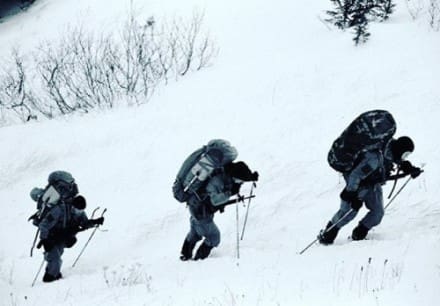Kyle Defoor published a 10-part series on shooting in the cold. In particular, he concentrates on clothing system selection.
My experience operating in the cold started in the military both in training and real world. I’ve worked in -25 up to just below freezing for long stretches (days not hours) of time. When I came into the military there was not a lot of good gear to be had. This changed later with consulting from Mark Twight via Natick Labs. Today we have more quality choices from more manufacturers but there is also more confusion in some areas. Hopefully this series of articles will help out those who are looking to buy quality gear for training in the elements for extended duration.
While you’re reading remember that exposure time is a major factor. A lot of students I see miss this important fact when showing up to a class. This happens with our military contracts too. I’ve heard comments early on about how we (instructors) are overdressed or that they (student) “don’t get cold”, “I’m from the North”, “I’m used to it”, etc. Somewhere around the hour mark completely exposed with no break is where most people realize basing your needs for shooting and training in the cold on the jacket you go get the mail in or take the dog for a walk with was a huge mistake.
Lastly, physical conditioning plays a huge role in staying warm. This mostly concerns circulation and over very long stretches, metabolism. Bottom line is the better shape your in both cardio wise and strength wise the easier your body can adapt to an unusual environment. I’ll leave you with the words of the Norwegians who’ve been training and shooting in cold conditions a long time arguably as good as anyone- “there is no bad weather, only bad gear”.
This is part 1, but the others can be found at kyledefoor.tumblr.com.
Tags: Kyle Defoor



My short time working during the winter months in Afghanistan was an enlightening experience so I’ll definitely be checking this out.
Read all 10 parts. Good stuff. Was neat to see that my system is 90% similar to yours as I struggled with cold weather up until about 6 years ago when I figured it out. The one think I did not understand was boots without built in insulation. Certainly you mean if you are active in the cold correct? Because from my experience, if your exposure time exceeds a couple of hours and you are having to be still (no activity), insulated boots are must. And again, I love Primaloft for that duty…in my experiences Thinsulate absolutely sucks.
Looking forward to the rest of this. The exposure time point is a great one – there is a huge difference between being out in the cold for a day/hours at a time versus living out of a pack in it for days on end.
I only shoot in the cold if I have a coat, long johns, a hat, gloves, and a heavy jacket. And it doesn’t even go below zero *F where I am.
I can totally confirm that. Grew up in area, where closure of schools happens when it’s -20F and two or more feet of snow layer is normal for several months. Spent pretty much time in Norwegian mountains, Swiss Alps and other nice but cold places.
So, I’ve noticed, how people, say, from Pacific Northwest can still wear shorts during the whole winter (even when it’s 32F or a bit colder). And it doesn’t normally happen in places with longer winters. But question is, how much extra food and hot drinks they need to compensate for that energy loss? Thicker insulation doesn’t mean you’re pussy, it means you’re not wasting energy when it’s cold. It’s easy to afford when your fridge and Dutch Bros. are not so far, but not somewhere in the mountains.
Not a ton of CW experience but yeah, either pack food or insulation. One lasts the other don’t!